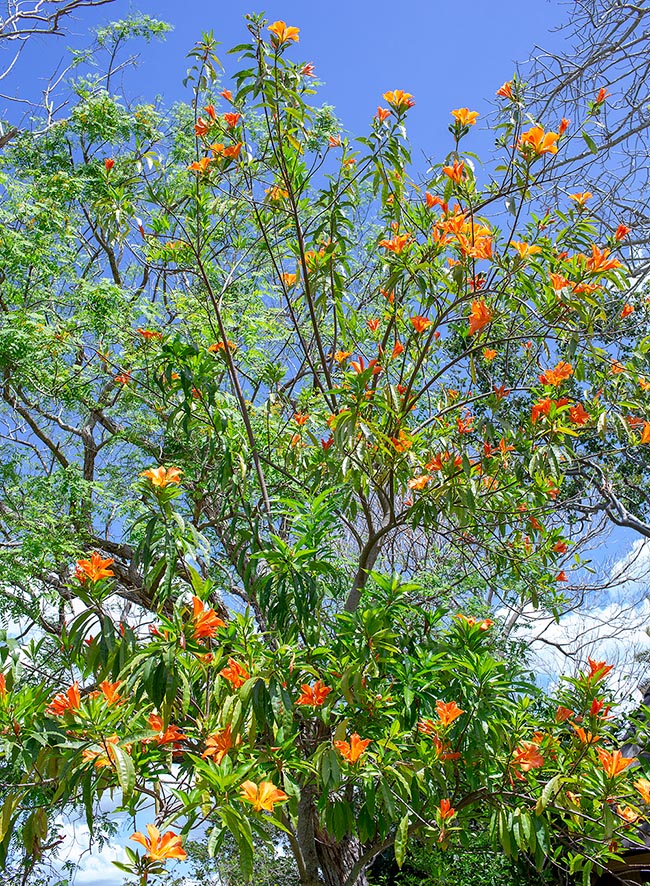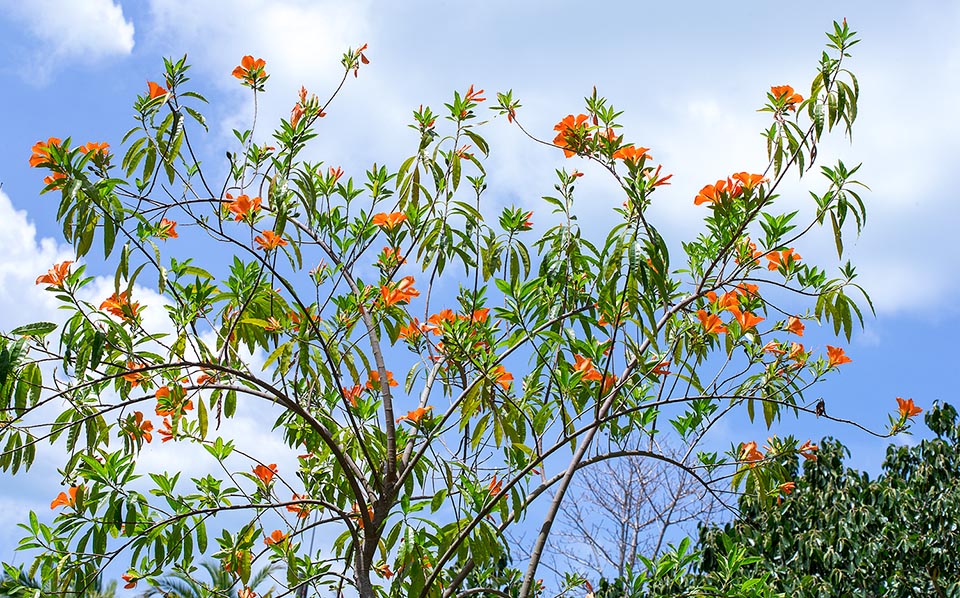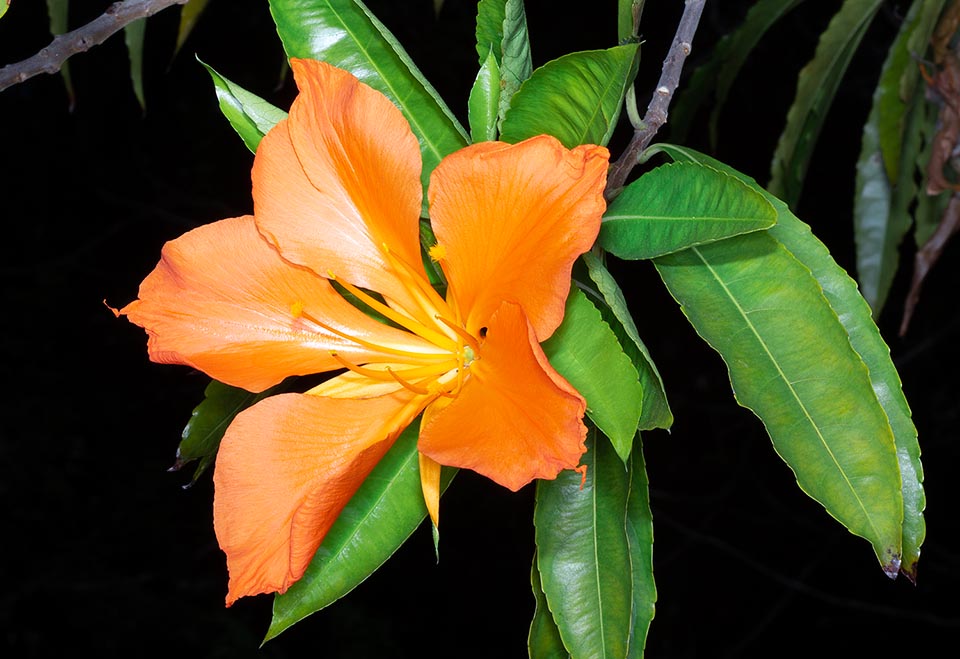Family : Passifloraceae

Text © Pietro Puccio

English translation by Mario Beltramini

Native to the humid Central America forests, from the sea level up to 2000 m of altitude, the Erblichia odorata is an arboreal relative to the passionflowers of our gardens that may reach 20 m of height with a 60 cm trunk © G. Mazza
The species is native to Belize, Costa Rica, El Salvador, Guatemala, Honduras, Mexico (Chiapas, Oaxaca, Nayarit, Puebla, Quintana Roo, Sinaloa, Tabasco, Tamaulipas and Veracruz), Nicaragua and Panama where it grows in the humid forests from the sea level up to about 2000 m of altitude.
The genus is dedicated to Ch. Erblich, one of the administrators of the Royal Gardens of Herrenhausen (Hannover); the name of the species is the Latin adjective “odoratus, a, um” = odorous, fragrant, with reference to the intensely fragrant flowers.
Common names: butterfly tree (English); conop (Belize); flor de fuego (El Salvador); candelaria, candelaria de montaña (Guatemala); axochi-tl, chamiso, copa de oro, flor de mayo, jarro de oro, sanjuanera, tulipán (Mexico); monterillo, pino amarillo (Panama).
The Erblichia odorata Seem. (1854) is an evergreen tree, 6-20 m tall, or more in the oldest specimens in the wild, with a 20-60 cm of diameter trunk with wrinkly brown-greyish bark and brown-yellowish young branches. The leaves, on a 0,6-1,2 cm long petiole, are alternate, simple, oblong-lanceolate with acuminate apex and irregularly toothed crenate-serrate margin, 5-16 cm long and 1,5-4 cm broad, of intense green colour and glossy above, pale green and glabrous or pubescent below. Solitary axillar flowers, fragrant, 7-8 cm long and of 13-18 cm of diameter, 2-3,5 long peduncle, lanceolate deciduous bracts, 1,4-2,8 cm long, 1-3 cm long pedicel, calyx with 5 oblong-lanceolate sepals having a long pointed apex, 4-6 cm long and 0,6-1 cm broad, of greenish yellow colour. Corolla with 5 obovate-oblong petals alternate to the sepals, 6-9 cm long and 3,5-4,6 cm broad, of golden yellow to reddish orange colour, corona reduced to an about 3 mm appendage at the base of the petals, 5 stamens with free filaments, of 4,5-5,3 cm, of orange colour and introrse anthers (turned inwards) erect and bilocular, greenish fusiform superior ovary, about 1 cm long and of 0,4 cm of diameter, and styles, 4-5 cm long, of orange colour. The fruit is an ellipsoidal trivalve capsula, 3-5 cm long and of 1,5-2 cm of diameter, containing numerous oblong-ovate seeds, about 5 mm long and of 3 mm of diameter, covered by orange pulp (aril).

Totally unknown in cultivation up to the end of the XX century, it rapidly grows in the gardens with tropical and subtropical climate © Giuseppe Mazza
Magnificent tree remained totally unknown in cultivation until the end of the XX century, when seeds and plants have begun to be available, even if initially in a very limited quantity. Cultivable in the tropical and subtropical climate regions in full sun on draining soils, preferably acidic or neutral, its cultivation may be tried in the mildest temperate-warm climates, where temperatures close to the 0 °C are exceptions of very short duration. It requires regular waterings, in particular in the climates characterized by long periods of dry, where it may partially lose the leaves, and fertilizations from spring to autumn with hydrosoluble balanced products with micro-elements.

The flowers, 13-18 cm broad are fragrant. Maybe it could be grown also in warm temperate climates or in luminous winter gardens © Giuseppe Mazza
Of fast growth, it adapts also to be cultivated in capacious containers for the decoration of open spaces or greenhouses and luminous winter gardens.
The wood, of average density, hard, easy to work and to finish, can be utilized in the constructions for indoor parts, furniture, plywood, fences, etc.
Synonyms: Piriqueta odorata (Seem.) Urb. (1883); Piriqueta xylocarpa Sprague & L.Riley (1923); Erblichia standleyi Steyerm. (1940); Erblichia xylocarpa (Sprague & L.Riley) Standl. & Steyerm. (1940); Erblichia xylocarpa var. mollis Standl. & Steyerm. (1940); Erblichia odorata var. mollis (Standl. & Steyerm.) L.O.Williams (1961).
→ To appreciate the biodiversity within PASSIFLORACEAE family please click here.
